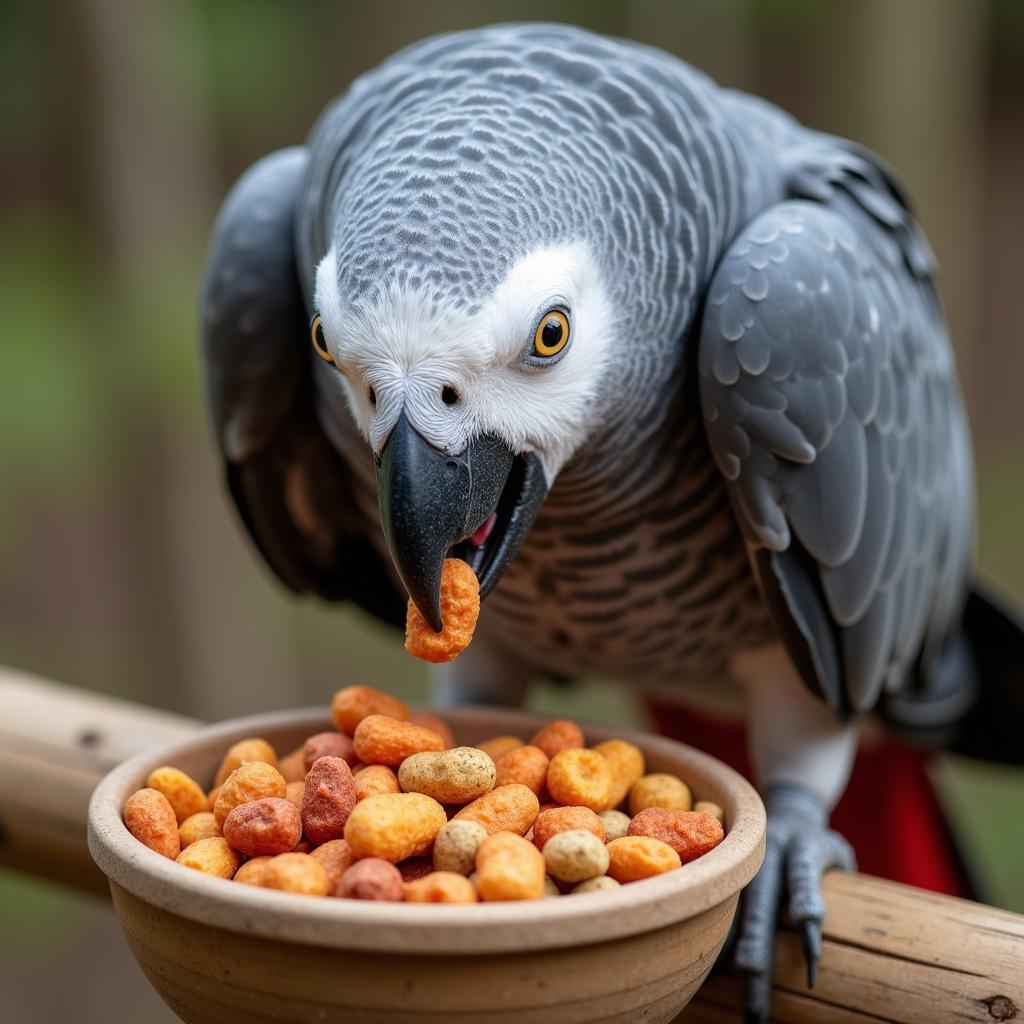The Ultimate African Grey Parrot Diet Chart: What to Feed Your Feathered Friend
The African grey parrot, known for its remarkable intelligence and ability to mimic human speech, is a popular companion bird. However, caring for these intelligent creatures goes beyond providing a spacious cage and stimulating toys. A crucial aspect of African grey parrot ownership is understanding their dietary needs. Providing a balanced and varied african grey diet chart is essential for their physical health, vibrant plumage, and overall well-being.
Decoding the African Grey Parrot Diet Chart: A Holistic Approach
Unlike seed-eating parrots, African greys thrive on a diverse diet that mimics what their wild counterparts would consume. A well-rounded african grey diet chart consists of high-quality formulated pellets, fresh fruits, vegetables, healthy grains, and occasional treats. Let’s delve into each component:
1. Formulated Pellets: The Foundation of a Healthy Diet
 African grey parrot enjoying a bowl of formulated pellets
African grey parrot enjoying a bowl of formulated pellets
High-quality formulated pellets should constitute approximately 60-70% of your African grey’s daily intake. These pellets are specifically designed to provide balanced nutrition, packed with essential vitamins, minerals, and amino acids that are crucial for your parrot’s health. Look for pellets that list whole grains or vegetables as the first few ingredients, avoiding those high in artificial colors, flavors, and preservatives.
2. Fresh Fruits and Vegetables: Nature’s Bounty of Vitamins
Fruits and vegetables should make up about 20-30% of your parrot’s diet. These colorful additions provide essential vitamins, minerals, and antioxidants that contribute to their overall health and vibrant plumage.
Here are some safe and nutritious options:
- Fruits: Apples (without seeds), bananas, berries (strawberries, blueberries, raspberries), grapes (cut in half), kiwi, mango, melons, oranges (peeled), papaya, peaches, pears.
- Vegetables: Asparagus, broccoli, carrots (chopped), celery, cooked sweet potatoes, leafy greens (kale, spinach, romaine lettuce), peas, peppers (red, yellow, orange), zucchini.
Important Note: Always wash fruits and vegetables thoroughly before serving and remove any seeds or pits that can be toxic to parrots.
3. Healthy Grains: A Source of Energy and Fiber
 African grey parrot enjoying a mix of healthy grains
African grey parrot enjoying a mix of healthy grains
Healthy grains provide essential carbohydrates for energy and fiber for digestion. Offer cooked grains like quinoa, brown rice, oats, and barley in moderation. Whole-wheat pasta and whole-grain bread (in small quantities) can also be offered occasionally.
4. Occasional Treats: Moderation is Key
While treats should be limited, offering them occasionally can enrich your parrot’s diet and provide mental stimulation. Nuts like almonds, walnuts, and pecans (unsalted and in shell) are excellent sources of healthy fats and protein. You can also offer small pieces of cooked lean chicken or hard-boiled eggs as occasional treats.
Word of Caution: Avoid avocados, chocolate, caffeine, alcohol, and salty or sugary foods, as these are toxic to parrots.
Crafting the Perfect African Grey Parrot Diet Chart: Tips and Tricks
- Variety is Key: Rotate the types of fruits, vegetables, and grains you offer to ensure a diverse nutrient intake.
- Introduce New Foods Gradually: When introducing a new food, offer it alongside your parrot’s favorite foods to encourage them to try it.
- Observe and Adjust: Monitor your parrot’s droppings and weight regularly. If you notice any changes, consult with an avian veterinarian to adjust their diet accordingly.
Understanding Your Parrot’s Needs: FAQs
1. How much should I feed my African Grey parrot daily?
A general guideline is to offer about 1/4 cup of formulated pellets and 1/4 cup of fresh fruits and vegetables daily. However, individual needs may vary depending on factors like age, activity level, and metabolism.
2. Can African Grey parrots eat seeds?
While seeds can be offered as occasional treats, they are high in fat and should not form the majority of their diet.
3. What are the signs of a nutritional deficiency in African Grey parrots?
Signs of nutritional deficiency include feather plucking, dull plumage, lethargy, weakness, and changes in droppings. If you notice any of these signs, consult an avian veterinarian immediately.
Ensuring a Long and Healthy Life for Your Feathered Friend
 A healthy and vibrant African grey parrot perched on a branch
A healthy and vibrant African grey parrot perched on a branch
Providing a balanced and nutritious african grey diet chart is crucial for ensuring a long, healthy, and vibrant life for your cherished companion. By understanding their dietary needs and offering a variety of healthy foods, you can help your African Grey parrot thrive and enjoy a fulfilling life by your side.
Remember, if you have any concerns about your parrot’s diet or health, always consult with a qualified avian veterinarian.
Need more information about your African Grey parrot’s care? Check out our other informative articles:
- African grey poop chart: Learn how to decode your parrot’s droppings to ensure their digestive health.
- African grape parrot: Discover fascinating facts about this closely related species.
For personalized guidance and support, don’t hesitate to reach out to us. Contact us at +255768904061, email us at kaka.mag@gmail.com, or visit our office at Mbarali DC Mawindi, Kangaga, Tanzania. Our dedicated team is available 24/7 to assist you in providing the best possible care for your feathered friend.


